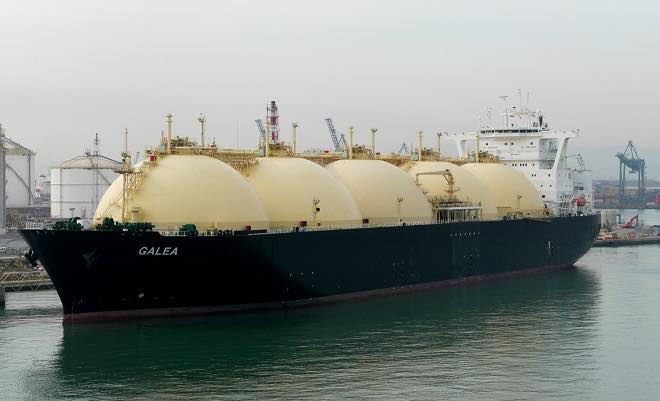April 2016, Vol. 243, No. 4
Web Exclusive
US to Undermine Russia’s Gas Monopoly In Europe

The first U.S. LNG shipment will soon arrive in Europe, marking a new era for energy on the continent. Cheniere Energy’s newly completed Sabine Pass facility on the U.S. Gulf Coast recently sent a shipment of American liquefied natural gas, which should arrive in Portugal within a few days.
“LNG coming out of the U.S. is probably the single most important thing that will transform the future LNG market,” Melissa Stark, energy managing director at Accenture, told Bloomberg. “It heralds the arrival of a global market.”
European LNG demand is rising as domestic natural gas production is falling. Europe’s LNG imports climbed by 16 percent in 2015 compared to a year earlier.
Cheniere’s exports alone won’t amount to much in the grand scheme of things, at least for now. But several more LNG export terminals are under construction along the Gulf Coast. “U.S. LNG supply to Europe may have strong geopolitical symbolism, but its current volume impact will be negligible, until the big volumes come on stream in 2018-19, and cargoes will probably go to higher value markets in Latin America and elsewhere,” Jonathan Stern of the Oxford Institute for Energy Studies, said in an email to Bloomberg.
U.S. LNG will have hard time competing with cheaper natural gas from Russia for the European market. Russia’s state-owned Gazprom said a few months ago that it wants to push gas exports to Europe to record levels and the company is confident that U.S. LNG won’t steal market share. Gazprom already supplies about one-third of European gas demand, and the Russian company wants to ramp up gas flows by 2 percent in 2016, with more increases coming in the years ahead. The vision is to continue to hold onto about 30 percent of the European market through 2035, according to a budget obtained by Bloomberg earlier this year.
Gazprom argues it can undercut U.S. LNG on price. “In a five-year perspective, the cost of U.S. LNG is seen higher than forward prices at the British hub NBP,” Alexander Medvedev, a top Gazprom official said in New York in January, referring to a benchmark natural gas price in the UK. “Imports of North American gas to Europe will be limited.”
Not everyone agrees. Earlier this year consulting firm Wood Mackenzie issued an estimate, projecting that 55 percent of U.S. LNG volumes, or about 32 million tonnes per year (mtpa), will be sent to Europe by 2020. While Asia often sees higher LNG spot prices, making it a desirable export destination, transportation costs for U.S. LNG destined for Europe are lower.
But Gazprom could block a lot of those cargoes by stepping up export volumes and selling them at prices below what can be achieved by U.S. LNG. Gazprom can export pipeline gas to Europe for $3.50 per million Btu (MMBtu) while American LNG would need prices of $4 to $5/MMbtu. Currently, Gazprom sells gas to Europe at a price of about $5.80/MMBtu on average, but could lower the price to beat U.S. LNG.
Of course, viewed another way, the growing U.S. export capacity – the mere existence of a competing source of supply – should push down the price that Gazprom is able to charge, a victory for Europe and a blow to Gazprom. Without U.S. LNG, its proponents argue, Russia would not be forced to accept lower prices. “It’s the start of the price war between U.S. LNG and pipeline gas,” said Thierry Bros, an analyst at Société Générale, according to the WSJ.
Another strategy for Gazprom is to expand pipeline connections to secure more buyers for a longer period of time. The Russian gas giant, along with several international gas companies, is pushing the Nord Stream 2 pipeline, an expansion of the existing conduit that connects Russian gas to Germany via the Baltic Sea. The proposed project has become highly controversial, with its sponsors – including E.ON, Wintershall, Shell, OMV, and Engie – arguing that the pipeline expansion is purely about business. Some governments in Eastern Europe see a more sinister plot to keep them hooked on Russian gas while depriving Ukraine its leverage as transit hub. Ukraine’s state-owned gas company Naftogaz calls Nord Stream 2 a “Trojan horse.”
On the other hand, if the project meets all legal requirements and the companies want to move forward, European politicians may have a tough time trying to slow it down. Speaking at an event at The Atlantic Council in early April, Friedbert Pfluger a Nonresident Senior Fellow at the Washington DC-based think tank, rejected the argument that the Nord Stream did not make commercial sense. “Who decides this? Is it government? Politicians? Are we in a planned market society? Do we teach Gazprom and the Russians that we know better as politicians than companies what the future market share and consumption in certain fields are?” Pfluger said.
By Nick Cunningham of Oilprice.com





Comments